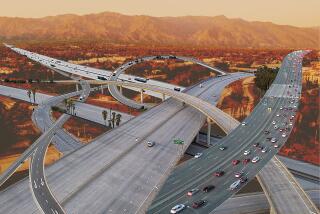Sharing Road With Truckers
John Kendall’s article (March 31) on trucks and the letters you have printed in response to it (April 10) convey the thought that the trucks and truckers are a menace to the law-abiding automobile drivers. Yes, there are dangerous trucks and drivers on the road, but the cumulative tone of Kendall’s article and the emotional letters are not a fair representation of the situation.
In 1981 I purchased a new Peterbilt and in the next 3 1/2 years logged more than 400,000 miles without a violation or accident of any kind. Are you interested in the opinion of a responsible, conscientious truck driver or do you wish to maintain the emotional and somewhat sensationalistic tone established by the article and letters?
To begin with, I offer no excuse or raise any defense for the irresponsible and dangerous truck drivers. In any given group, whether it be doctors, lawyers, journalists, heads of state, automobile drivers or any other group you wish to name, about 2% of the total are wackos. Truck drivers are no different.
Make no mistake, the responsible drivers and the owners of the trucking companies want the dangerous 2% off the road. It may come as some surprise, but the trucking companies are adamant about removing drivers who demonstrate irresponsibility or dangerous driving habits. Therefore, the best way to get them off the road is to report them to the trucking company.
A large, identifying number is on the left front and left rear of the cab. The same is true of the trailers. Reporting the number of either the tractor or the trailer along with the date and time of day will allow the trucking company to identify the driver quickly. And there will be an investigation. You can count on it. But before you submit such a report, make sure it is, in fact, an irresponsible act rather than a normal maneuver that you would accept as commonplace for another automobile.
It is obvious from your letters that people are scared of the trucks. This is not an unfounded fear. A loaded “18-wheeler” in motion can run right over a “4-wheeler,” leaving it and its occupants mashed on the ground. There is no contest between an automobile and a truck grossed at 75,000 pounds. However, it may also be surprising to learn that the truck drivers are scared to death of the automobile drivers for many reasons.
It is often said that every over-the-road truck driver saves at least one life a week. From personal experience, there is a great deal of validity to this generalization. I cannot count the times I had to “lock-it-down,” lay expensive rubber on the road to avoid running over automobiles whose drivers, stupidly or carelessly, put themselves directly in my path, a path that was open and clear before the arrival of the automobile. The most common offense is the automobile driver who passes a truck, pulls back right in front of the truck and applies brakes. What had been a comfortable safety cushion of space for the truck driver has suddenly changed to imminent disaster.
Please keep in mind that the truck has as much right to be on the road as do you and the truck driver needs a lot of space to turn and maneuver. If you are observant you will see that, in general, the trucks are yielding to give automobiles the space they need, but the truck drivers have to fight to get the space they have to have.
This leads to an attitude in the truck drivers of “they don’t give a damn, why should I?” It leads to a level of irritation that is dangerous, but a simple act of courtesy will restore things to normal.
It has happened to me a number of times in heavy traffic. I have felt the irritation growing when automobile drivers have refused to give me the space I had to have. Then, one knowledgeable and courteous automobile driver slowed down and flashed his headlights on and off to tell me that he would stay out of the way while I made the move I had to make. That simple act of courtesy told me that someone cared about my needs and the tension was gone. Try it sometime. Start giving the truck driver the space he needs instead of the upraised finger that is so popular in California and a lot of attitudes will change, including your own.
STERLING H. SAUNDERS
Los Angeles






